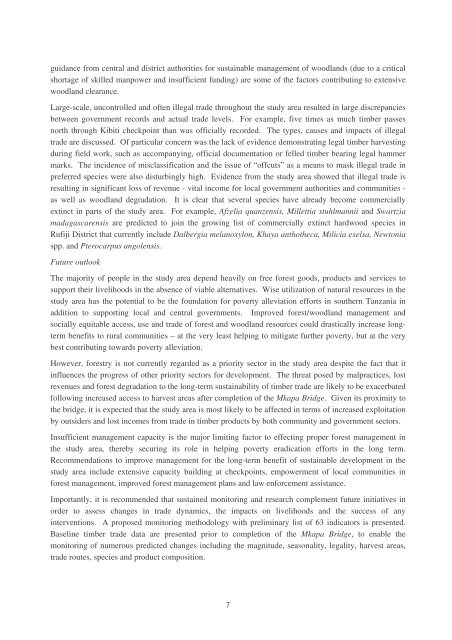Bridging the Gap: linking timber trade with infrastructural ...
Bridging the Gap: linking timber trade with infrastructural ...
Bridging the Gap: linking timber trade with infrastructural ...
Create successful ePaper yourself
Turn your PDF publications into a flip-book with our unique Google optimized e-Paper software.
guidance from central and district authorities for sustainable management of woodlands (due to a critical<br />
shortage of skilled manpower and insufficient funding) are some of <strong>the</strong> factors contributing to extensive<br />
woodland clearance.<br />
Large-scale, uncontrolled and often illegal <strong>trade</strong> throughout <strong>the</strong> study area resulted in large discrepancies<br />
between government records and actual <strong>trade</strong> levels. For example, five times as much <strong>timber</strong> passes<br />
north through Kibiti checkpoint than was officially recorded. The types, causes and impacts of illegal<br />
<strong>trade</strong> are discussed. Of particular concern was <strong>the</strong> lack of evidence demonstrating legal <strong>timber</strong> harvesting<br />
during field work, such as accompanying, official documentation or felled <strong>timber</strong> bearing legal hammer<br />
marks. The incidence of misclassification and <strong>the</strong> issue of “offcuts” as a means to mask illegal <strong>trade</strong> in<br />
preferred species were also disturbingly high. Evidence from <strong>the</strong> study area showed that illegal <strong>trade</strong> is<br />
resulting in significant loss of revenue - vital income for local government authorities and communities -<br />
as well as woodland degradation. It is clear that several species have already become commercially<br />
extinct in parts of <strong>the</strong> study area. For example, Afzelia quanzensis, Millettia stuhlmannii and Swartzia<br />
madagascarensis are predicted to join <strong>the</strong> growing list of commercially extinct hardwood species in<br />
Rufiji District that currently include Dalbergia melanoxylon, Khaya antho<strong>the</strong>ca, Milicia exelsa, Newtonia<br />
spp. and Pterocarpus angolensis.<br />
Future outlook<br />
The majority of people in <strong>the</strong> study area depend heavily on free forest goods, products and services to<br />
support <strong>the</strong>ir livelihoods in <strong>the</strong> absence of viable alternatives. Wise utilization of natural resources in <strong>the</strong><br />
study area has <strong>the</strong> potential to be <strong>the</strong> foundation for poverty alleviation efforts in sou<strong>the</strong>rn Tanzania in<br />
addition to supporting local and central governments. Improved forest/woodland management and<br />
socially equitable access, use and <strong>trade</strong> of forest and woodland resources could drastically increase longterm<br />
benefits to rural communities – at <strong>the</strong> very least helping to mitigate fur<strong>the</strong>r poverty, but at <strong>the</strong> very<br />
best contributing towards poverty alleviation.<br />
However, forestry is not currently regarded as a priority sector in <strong>the</strong> study area despite <strong>the</strong> fact that it<br />
influences <strong>the</strong> progress of o<strong>the</strong>r priority sectors for development. The threat posed by malpractices, lost<br />
revenues and forest degradation to <strong>the</strong> long-term sustainability of <strong>timber</strong> <strong>trade</strong> are likely to be exacerbated<br />
following increased access to harvest areas after completion of <strong>the</strong> Mkapa Bridge. Given its proximity to<br />
<strong>the</strong> bridge, it is expected that <strong>the</strong> study area is most likely to be affected in terms of increased exploitation<br />
by outsiders and lost incomes from <strong>trade</strong> in <strong>timber</strong> products by both community and government sectors.<br />
Insufficient management capacity is <strong>the</strong> major limiting factor to effecting proper forest management in<br />
<strong>the</strong> study area, <strong>the</strong>reby securing its role in helping poverty eradication efforts in <strong>the</strong> long term.<br />
Recommendations to improve management for <strong>the</strong> long-term benefit of sustainable development in <strong>the</strong><br />
study area include extensive capacity building at checkpoints, empowerment of local communities in<br />
forest management, improved forest management plans and law enforcement assistance.<br />
Importantly, it is recommended that sustained monitoring and research complement future initiatives in<br />
order to assess changes in <strong>trade</strong> dynamics, <strong>the</strong> impacts on livelihoods and <strong>the</strong> success of any<br />
interventions. A proposed monitoring methodology <strong>with</strong> preliminary list of 63 indicators is presented.<br />
Baseline <strong>timber</strong> <strong>trade</strong> data are presented prior to completion of <strong>the</strong> Mkapa Bridge, to enable <strong>the</strong><br />
monitoring of numerous predicted changes including <strong>the</strong> magnitude, seasonality, legality, harvest areas,<br />
<strong>trade</strong> routes, species and product composition.<br />
7
















